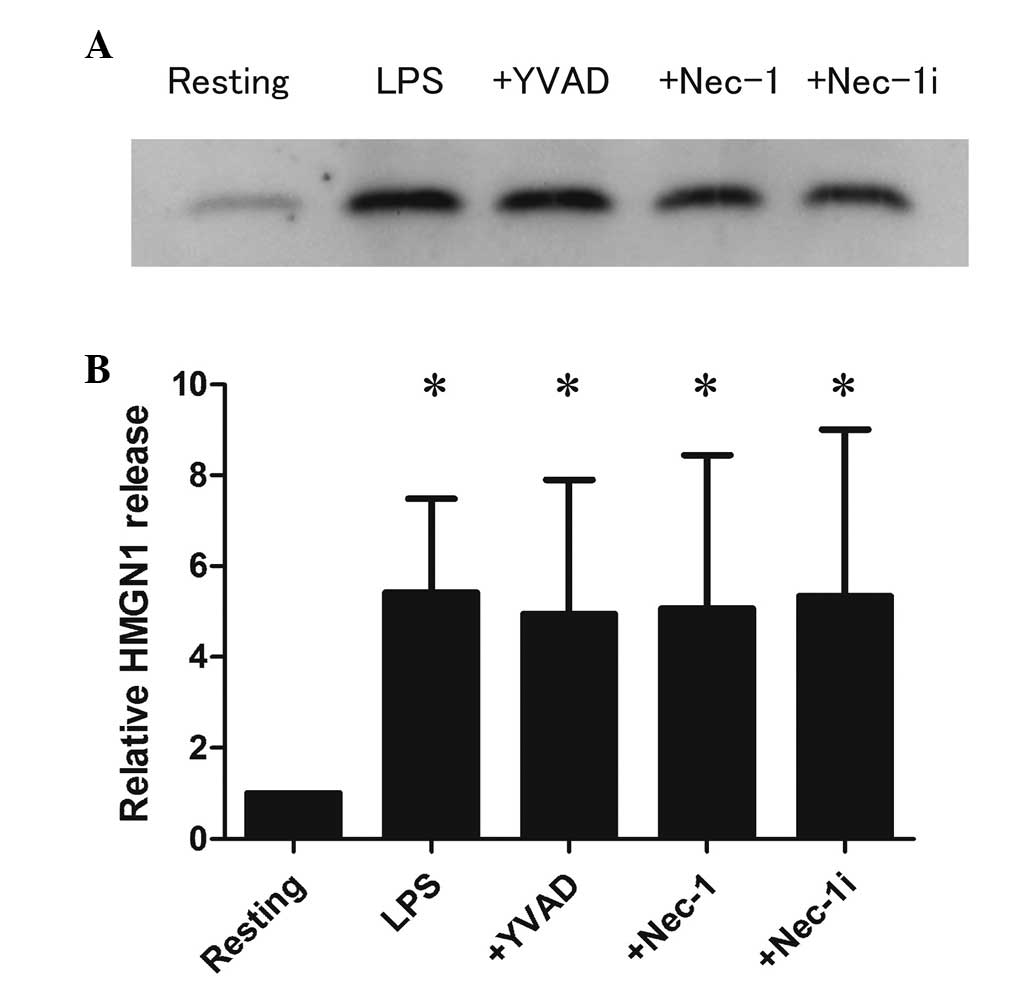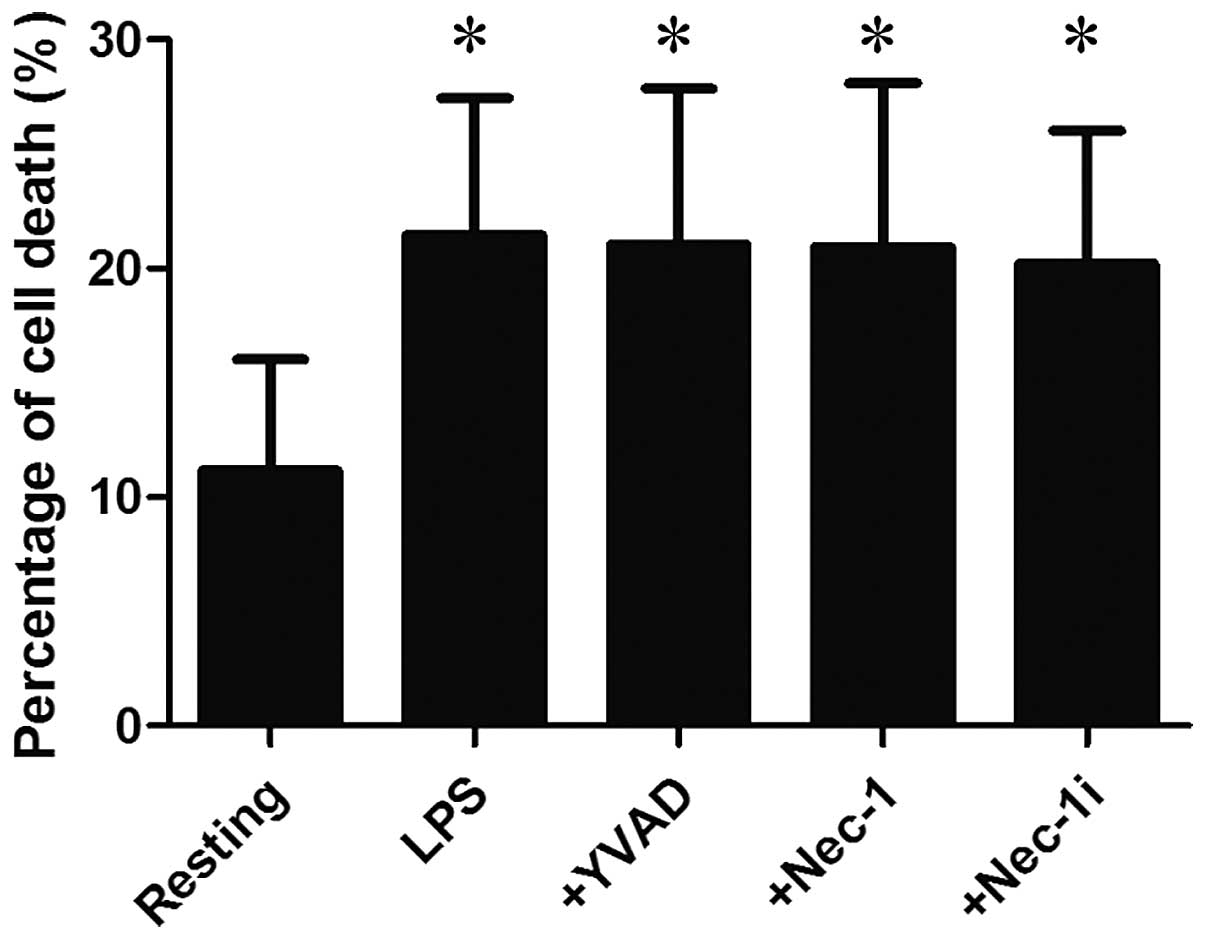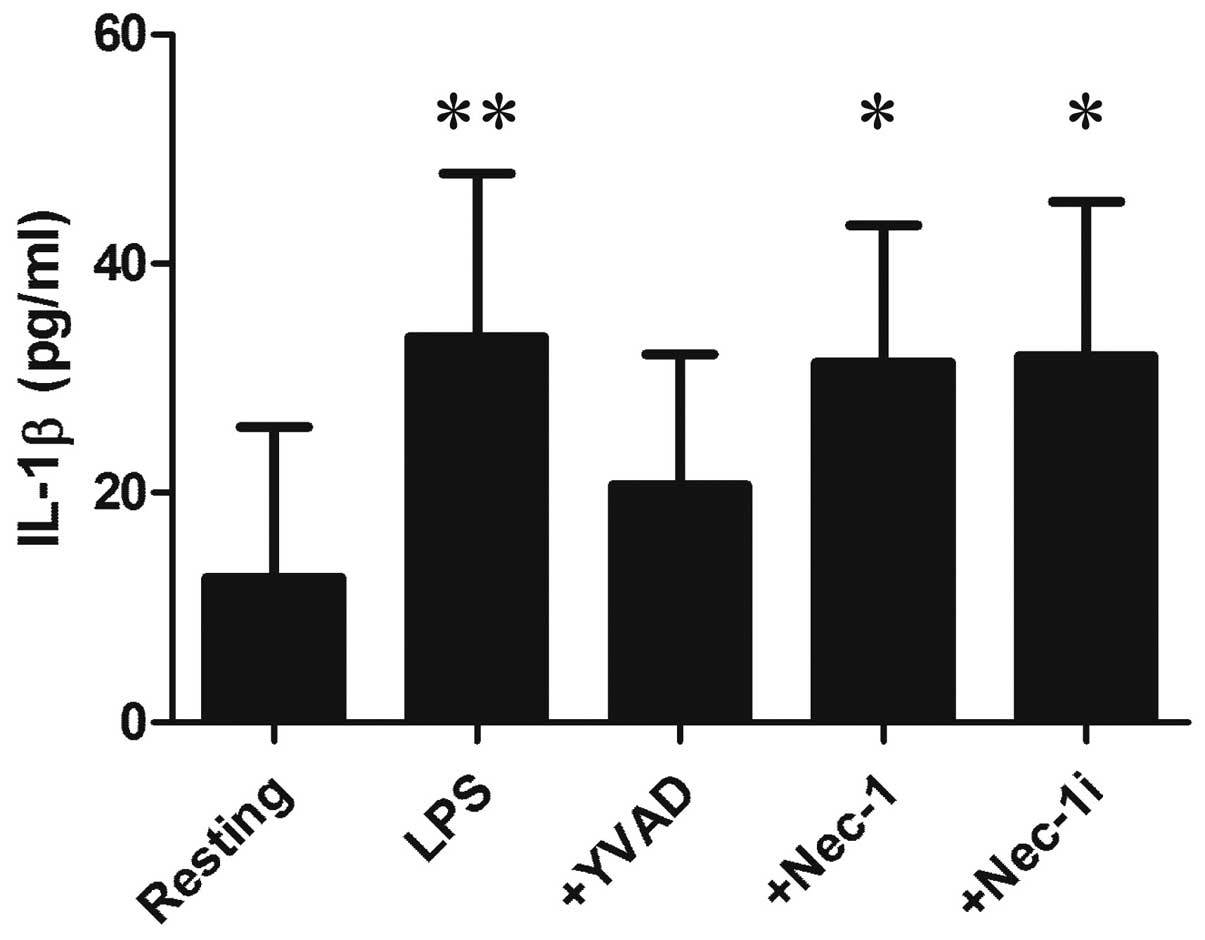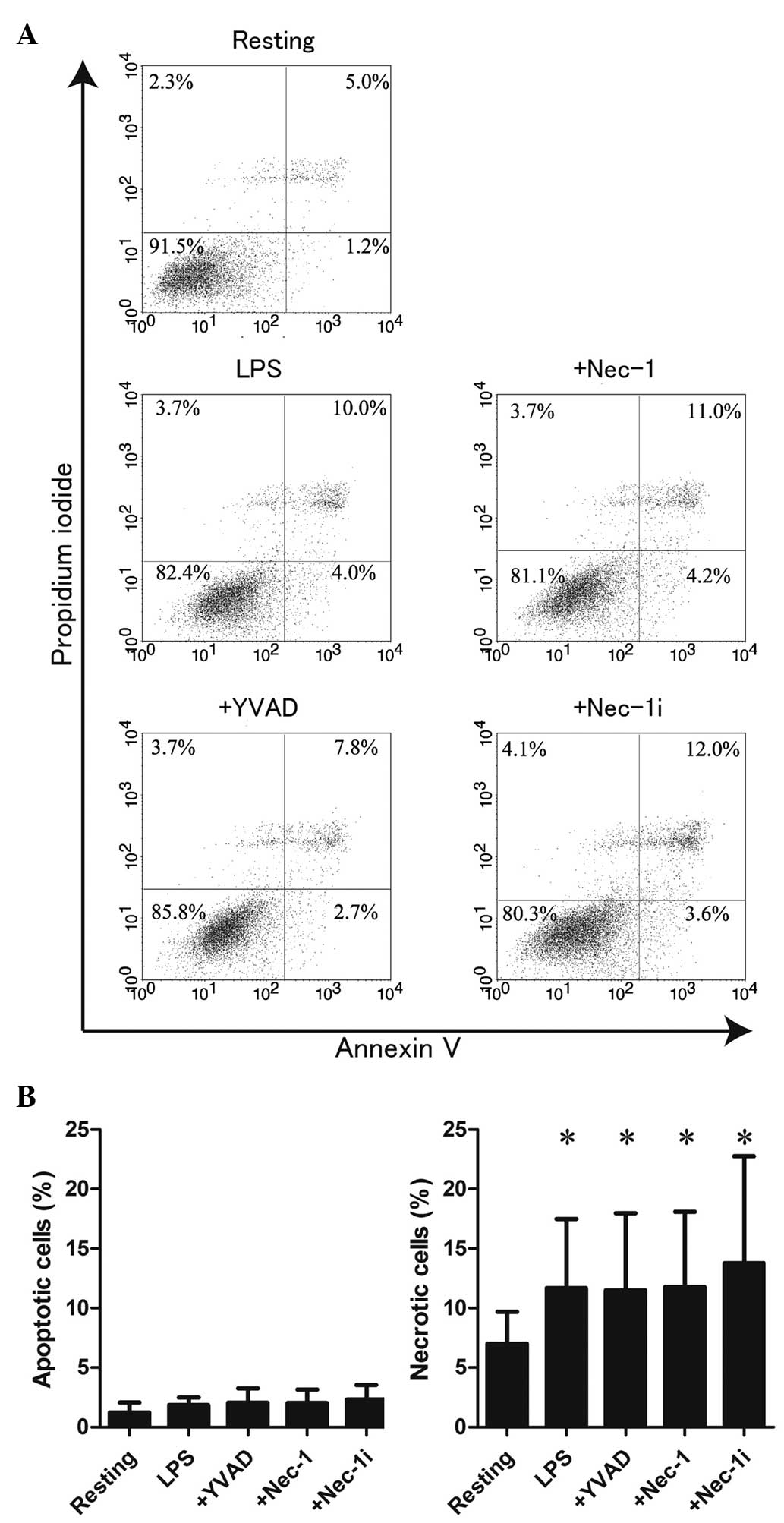|
1
|
Cohen J: The immunopathogenesis of sepsis.
Nature. 420:885–891. 2002. View Article : Google Scholar : PubMed/NCBI
|
|
2
|
O'Brien JM Jr, Ali NA, Aberegg SK and
Abraham E: Sepsis. Am J Med. 120:1012–1022. 2007. View Article : Google Scholar : PubMed/NCBI
|
|
3
|
Van Amersfoort ES, Van Berkel TJ and
Kuiper J: Receptors, mediators, and mechanisms involved in
bacterial sepsis and septic shock. Clin Microbiol Rev. 16:379–414.
2003. View Article : Google Scholar : PubMed/NCBI
|
|
4
|
Manson J, Thiemermann C and Brohi K:
Trauma alarmins as activators of damage-induced inflammation. Br J
Surg. 99(Suppl 1): S12–S20. 2012. View
Article : Google Scholar
|
|
5
|
Tewary P, de la Rosa G, Sharma N,
Rodriguez LG, Tarasov SG, Howard OM, Shirota H, Steinhagen F,
Klinman DM, Yang D and Oppenheim JJ: β-Defensin 2 and 3 promote the
uptake of self or CpG DNA, enhance IFN-α production by human
plasmacytoid dendritic cells, and promote inflammation. J Immunol.
191:865–874. 2013. View Article : Google Scholar : PubMed/NCBI
|
|
6
|
Nagaoka I, Tamura H and Hirata M: An
antimicrobial cathelicidin peptide, human CAP18/LL-37, suppresses
neutrophil apoptosis via the activation of formyl-peptide
receptor-like 1 and P2×7. J Immunol. 176:3044–3052. 2006.
View Article : Google Scholar : PubMed/NCBI
|
|
7
|
Suzuki K, Murakami T, Kuwahara-Arai K,
Tamura H, Hiramatsu K and Nagaoka I: Human anti-microbial
cathelicidin peptide LL-37 suppresses the LPS-induced apoptosis of
endo-thelial cells. Int Immunol. 23:185–193. 2011. View Article : Google Scholar : PubMed/NCBI
|
|
8
|
Moussion C, Ortega N and Girard JP: The
IL-1-like cytokine IL-33 is constitutively expressed in the nucleus
of endothelial cells and epithelial cells in vivo: A novel
'alarmin'? PLoS One. 3:e33312008. View Article : Google Scholar : PubMed/NCBI
|
|
9
|
Bianchi ME: DAMPs, PAMPs and alarmins: All
we need to know about danger. J Leukoc Biol. 81:1–5. 2007.
View Article : Google Scholar
|
|
10
|
Yang Z, Li L, Chen L, Yuan W, Dong L,
Zhang Y, Wu H and Wang C: PARP-1 mediates LPS-induced HMGB1 release
by macrophages through regulation of HMGB1 acetylation. J Immunol.
193:6114–6123. 2014. View Article : Google Scholar : PubMed/NCBI
|
|
11
|
Hu Z, Murakami T, Suzuki K, Tamura H,
Kuwahara-Arai K, Iba T and Nagaoka I: Antimicrobial cathelicidin
peptide LL-37 inhibits the LPS/ATP-induced pyroptosis of
macrophages by dual mechanism. PLoS One. 9:e857652014. View Article : Google Scholar : PubMed/NCBI
|
|
12
|
Lamkanfi M and Dixit VM: Modulation of
inflammasome pathways by bacterial and viral pathogens. J Immunol.
187:597–602. 2011. View Article : Google Scholar : PubMed/NCBI
|
|
13
|
Wei F, Yang D, Tewary P, Li Y, Li S, Chen
X, Howard OM, Bustin M and Oppenheim JJ: The Alarmin HMGN1
contributes to antitumor immunity and is a potent immunoadjuvant.
Cancer Res. 74:5989–5998. 2014. View Article : Google Scholar : PubMed/NCBI
|
|
14
|
Yang D, Postnikov YV, Li Y, Tewary P, de
la Rosa G, Wei F, Klinman D, Gioannini T, Weiss JP, Furusawa T, et
al: High-mobility group nucleosome-binding protein 1 acts as an
alarmin and is critical for lipopolysaccharide-induced immune
responses. J Exp Med. 209:157–171. 2012. View Article : Google Scholar :
|
|
15
|
Magna M and Pisetsky DS: The role of HMGB1
in the pathogenesis of inflammatory and autoimmune diseases. Mol
Med. 20:138–146. 2014. View Article : Google Scholar : PubMed/NCBI
|
|
16
|
Murakami T, Suzuki K, Tamura H and Nagaoka
I: Suppressive action of resolvin D1 on the production and release
of septic mediators in D-galactosamine-sensitized endotoxin shock
mice. Exp Ther Med. 2:57–61. 2011.PubMed/NCBI
|
|
17
|
Kugler JE, Horsch M, Huang D, Furusawa T,
Rochman M, Garrett L, Becker L, Bohla A, Hölter SM, Prehn C, et al:
High mobility group N proteins modulate the fidelity of the
cellular transcriptional profile in a tissue- and variant-specific
manner. J Biol Chem. 288:16690–16703. 2013. View Article : Google Scholar : PubMed/NCBI
|
|
18
|
Gerlitz G: HMGNs, DNA repair and cancer.
Biochim Biophys Acta. 1799:80–85. 2010. View Article : Google Scholar :
|
|
19
|
Cho Y, McQuade T, Zhang H, Zhang J and
Chan FK: RIP1-dependent and independent effects of necrostatin-1 in
necrosis and T cell activation. PLoS One. 6:e232092011. View Article : Google Scholar : PubMed/NCBI
|
|
20
|
Kaczmarek A, Vandenabeele P and Krysko DV:
Necroptosis: The release of damage-associated molecular patterns
and its physiological relevance. Immunity. 38:209–223. 2013.
View Article : Google Scholar : PubMed/NCBI
|
|
21
|
Moquin DM, McQuade T and Chan FK: CYLD
deubiquitinates RIP1 in the TNFα-induced necrosome to facilitate
kinase activation and programmed necrosis. PLoS One. 8:e768412013.
View Article : Google Scholar
|
|
22
|
Wree A, Eguchi A, McGeough MD, Pena CA,
Johnson CD, Canbay A, Hoffman HM and Feldstein AE: NLRP3
inflammasome activation results in hepatocyte pyroptosis, liver
inflammation and fibrosis in mice. Hepatology. 59:898–910. 2014.
View Article : Google Scholar :
|
|
23
|
Khan MJ, Rizwan Alam M, Waldeck-Weiermair
M, Karsten F, Groschner L, Riederer M, Hallström S, Rockenfeller P,
Konya V, Heinemann A, et al: Inhibition of autophagy rescues
palmitic acid-induced necroptosis of endothelial cells. J Biol
Chem. 287:21110–21120. 2012. View Article : Google Scholar : PubMed/NCBI
|
|
24
|
Zong WX and Thompson CB: Necrotic death as
a cell fate. Genes Dev. 20:1–15. 2006. View Article : Google Scholar : PubMed/NCBI
|
|
25
|
Davidovich P, Kearney CJ and Martin SJ:
Inflammatory outcomes of apoptosis, necrosis and necroptosis. Biol
Chem. 395:1163–1171. 2014. View Article : Google Scholar : PubMed/NCBI
|
|
26
|
Inoue H and Tani K: Multimodal immunogenic
cancer cell death as a consequence of anticancer cytotoxic
treatments. Cell Death Differ. 21:39–49. 2014. View Article : Google Scholar
|
|
27
|
Cervantes J, Nagata T, Uchijima M, Shibata
K and Koide Y: Intracytosolic listeria monocytogenes induces cell
death through caspase-1 activation in murine macrophages. Cell
Microbiol. 10:41–52. 2008.
|
|
28
|
Lamkanfi M and Dixit VM: Mechanisms and
functions of inflammasomes. Cell. 157:1013–1022. 2014. View Article : Google Scholar : PubMed/NCBI
|
|
29
|
Degterev A, Huang Z, Boyce M, Li Y, Jagtap
P, Mizushima N, Cuny GD, Mitchison TJ, Moskowitz MA and Yuan J:
Chemical inhibitor of nonapoptotic cell death with therapeutic
potential for ischemic brain injury. Nat Chem Biol. 1:112–119.
2005. View Article : Google Scholar
|
|
30
|
Yamanaka K, Urano Y, Takabe W, Saito Y and
Noguchi N: Induction of apoptosis and necroptosis by
24(S)-hydroxycholesterol is dependent on activity of acyl-CoA:
Cholesterol acyltransferase 1. Cell Death Dis. 5:e9902014.
View Article : Google Scholar
|
|
31
|
Steinhart L, Belz K and Fulda S: Smac
mimetic and demeth-ylating agents synergistically trigger cell
death in acute myeloid leukemia cells and overcome apoptosis
resistance by inducing necroptosis. Cell Death Dis. 4:e8022013.
View Article : Google Scholar
|
|
32
|
Tseng WA, Thein T, Kinnunen K, Lashkari K,
Gregory MS, D'Amore PA and Ksander BR: NLRP3 inflammasome
activation in retinal pigment epithelial cells by lysosomal
destabilization: Implications for age-related macular degeneration.
Invest Ophthalmol Vis Sci. 54:110–120. 2013. View Article : Google Scholar :
|
|
33
|
Sauer JD, Witte CE, Zemansky J, Hanson B,
Lauer P and Portnoy DA: Listeria monocytogenes triggers
AIM2-mediated pyroptosis upon infrequent bacteriolysis in the
macrophage cytosol. Cell Host Microbe. 7:412–419. 2010. View Article : Google Scholar : PubMed/NCBI
|
|
34
|
Hua KF, Chou JC, Ka SM, Tasi YL, Chen A,
Wu SH, Chiu HW, Wong WT, Wang YF, Tsai CL, et al: Cyclooxygenase-2
regulates NLRP3 inflammasome-derived IL-1β production. J Cell
Physiol. 230:863–874. 2015. View Article : Google Scholar
|
|
35
|
Diener KR, Al-Dasooqi N, Lousberg EL and
Hayball JD: The multifunctional alarmin HMGB1 with roles in the
pathophysiology of sepsis and cancer. Immunol Cell Biol.
91:443–450. 2013. View Article : Google Scholar : PubMed/NCBI
|
|
36
|
Wang H, Ward MF and Sama AE: Targeting
HMGB1 in the treatment of sepsis. Expert Opin Ther Targets.
18:257–268. 2014. View Article : Google Scholar : PubMed/NCBI
|
|
37
|
Webster NR and Galley HF: Immunomodulation
in the critically ill. Br J Anaesth. 103:70–81. 2009. View Article : Google Scholar : PubMed/NCBI
|


















